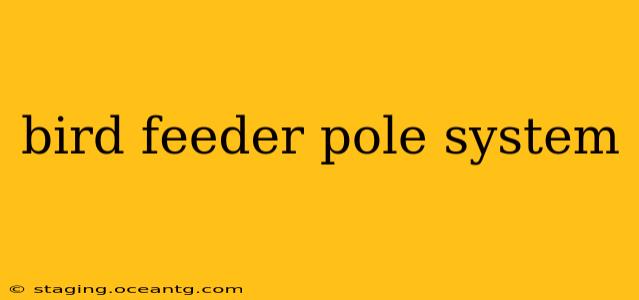Attracting birds to your backyard is a rewarding experience, offering hours of entertainment and a connection with nature. A bird feeder pole system is key to providing a safe and convenient feeding station for your feathered friends. But with so many options available, choosing the right system can feel overwhelming. This guide will walk you through everything you need to know about bird feeder pole systems, helping you select and install the perfect setup for your backyard.
What is a Bird Feeder Pole System?
A bird feeder pole system consists of a sturdy pole, typically made of metal or treated wood, designed to elevate bird feeders above the ground. This elevation serves several crucial purposes:
- Predator Protection: Raising feeders prevents ground predators like cats, raccoons, and rats from easily accessing the food.
- Improved Bird Access: Birds feel safer approaching feeders at a height, reducing stress and encouraging frequent visits.
- Aesthetic Appeal: A well-placed pole system adds a touch of elegance and natural charm to your garden.
The system typically includes the pole itself, a ground anchor or base for stability, and sometimes additional features like baffles or cages to further deter predators.
What are the Different Types of Bird Feeder Pole Systems?
Several types of bird feeder pole systems cater to different needs and preferences:
- Metal Poles: These are durable, resistant to weather damage, and often adjustable in height. They're a popular choice for their longevity.
- Wooden Poles: Wooden poles offer a more natural aesthetic but require regular maintenance to prevent rot and insect damage. Choosing treated wood is essential for longevity.
- Adjustable Height Poles: These allow you to customize the feeder's height based on the types of birds you want to attract and the surrounding landscape.
- Ground-mounted Poles: These are fixed directly into the ground using a sturdy anchor or concrete base.
- Free-standing Poles: These are standalone poles without any need for ground installation, often incorporating a weighted base for stability.
How to Choose the Right Bird Feeder Pole System?
Selecting the best bird feeder pole system depends on several factors:
- Your Budget: Prices vary significantly depending on the material, height, and features.
- Your Yard's Landscape: Consider the size of your yard and the presence of trees or other structures that might affect pole placement.
- Predator Prevalence: If you have a high density of ground predators, a system with extra predator deterrents is vital.
- Desired Height: The height should be sufficient to deter predators while still allowing easy access for birds. Taller poles are generally better for larger birds.
- Aesthetic Preferences: Choose a pole material and design that complements your backyard’s style.
How to Install a Bird Feeder Pole System?
Proper installation is crucial for the safety and effectiveness of your bird feeder pole system. Here's a general guide:
- Choose a Location: Select a spot away from overhanging branches and other obstructions that birds might collide with during flight.
- Prepare the Ground: If using a ground-mounted pole, dig a hole deep enough to securely anchor the base.
- Secure the Base: Use concrete or a specialized anchor to firmly fix the pole in place.
- Attach the Pole: Follow the manufacturer's instructions for assembling and attaching the pole to the base.
- Add Baffles (if necessary): Baffles prevent squirrels and other climbing predators from reaching the feeder.
- Mount the Feeder: Securely attach your bird feeder to the pole.
Always consult the specific instructions provided with your chosen bird feeder pole system.
What height should my bird feeder pole be?
The ideal height for your bird feeder pole depends on several factors including the size of the birds you wish to attract, the surrounding vegetation and the presence of potential predators. As a general guideline, aim for at least 6 feet, but higher is often better for larger birds and increased predator protection.
How do I keep squirrels off my bird feeder pole?
Squirrels are notorious for raiding bird feeders. To keep them away, consider using:
- Baffles: These are cone-shaped or cylindrical devices that prevent squirrels from climbing the pole.
- Squirrel-resistant feeders: Some feeders are specifically designed with features that make it difficult for squirrels to access the food.
- Metal poles: Squirrels find it harder to climb smooth metal poles compared to wooden ones.
- Grease or sticky bands: These can act as a deterrent, but they may also harm birds, so use with caution.
What materials are best for a bird feeder pole?
Metal (steel or aluminum) and treated wood are the most popular materials for bird feeder poles. Metal poles are more durable and weather-resistant, while treated wood offers a more natural aesthetic. Always ensure any wooden pole is treated to withstand the elements and prevent rot.
How do I prevent birds from pooping all over my bird feeder pole?
Unfortunately, you can't entirely prevent birds from pooping on their feeding station. However, you can minimize the mess by:
- Regularly cleaning the pole and the area underneath.
- Choosing a location with good airflow to help keep things dry.
- Using a pole that's easy to clean and maintain.
By following this guide and considering your individual needs, you can create a thriving bird feeder station that benefits both you and your feathered friends. Remember to choose high-quality materials and install the system correctly for optimal results and years of enjoyable birdwatching.
